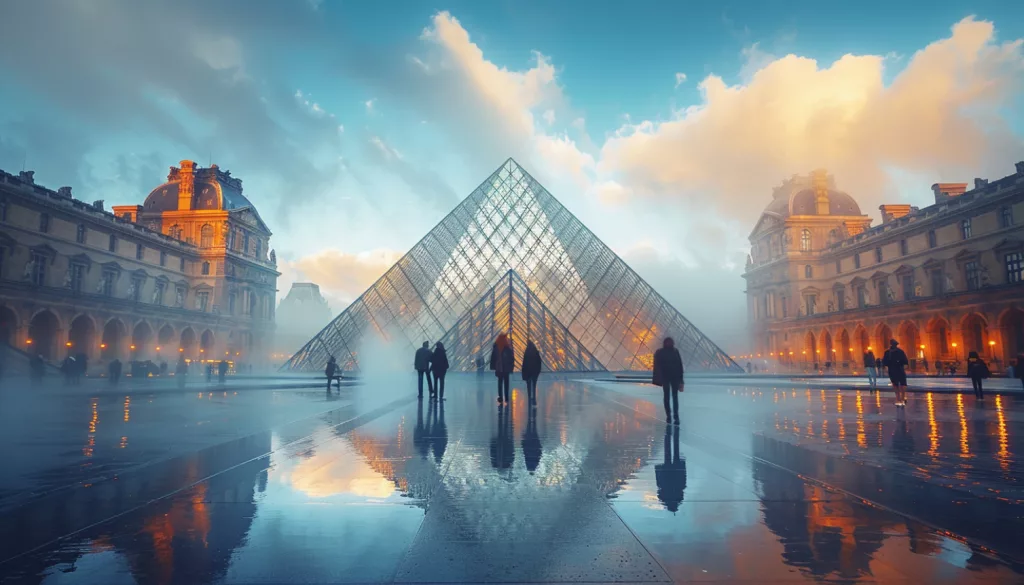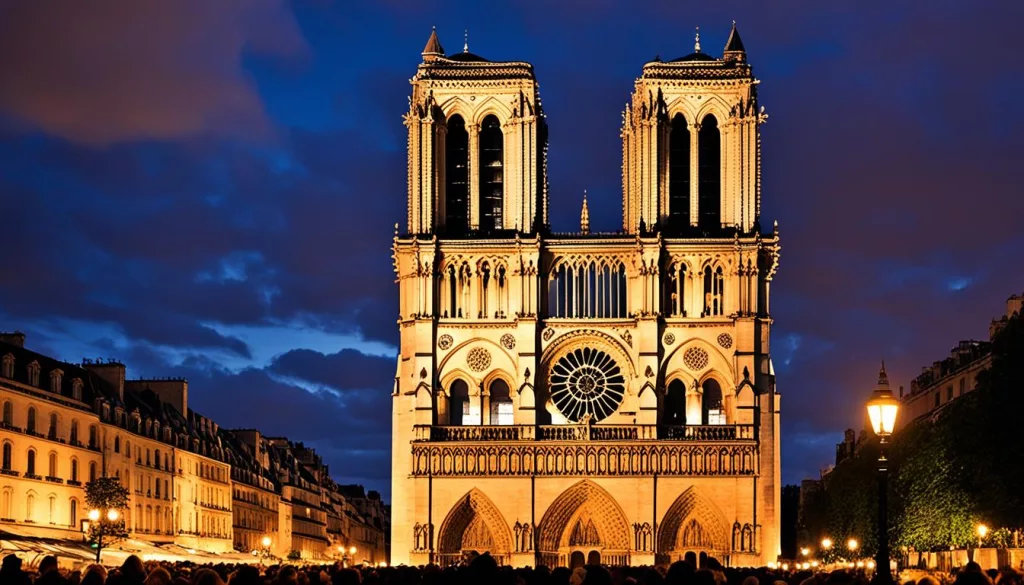Bonjour and happy to walk you through Paris historical sites and landmarks guide! In this article we will join you in the voyage from the bustling attractions to the intriguing past and to the history of the City of Light. From must-be visited historical sites to world-famous landmarks, there are so many places about which to passionately talk for history lovers like us.
The Parisian reputation lies in its rich cultural legacy and monumental architectural treasures spanning over a millennium. Whether it’s on a stroll by the wonderful Seine River or walking through enchanted areas like Montmartre, history is what welcomes you everywhere. Let us venture into this wonderful town in Paris, which makes it a fascinating place through the top historical attractions that it possesses.
Key Takeaways:
- Paris is home to numerous historical sites and landmarks that attract visitors from around the world.
- The Louvre Museum, Eiffel Tower, Catacombs of Paris, and Notre Dame Cathedral are just a few of the must-see attractions.
- Each landmark offers a unique glimpse into Paris’s history, from ancient artifacts and iconic artwork to Gothic architecture and somber catacombs.
- Exploring these historical sites allows you to immerse yourself in the rich history and culture of Paris, providing an unforgettable experience.
- Plan your visit in advance to make the most of your time and consider hiring audio guides for a more immersive experience.
Musee du Louvre
The Musee du Louvre is a world-renowned museum that houses over 35,000 pieces of art and historical artifacts from around the world. From Ancient Egyptian mummies to the iconic painting of Mona Lisa by Leonardo da Vinci, there is an extensive collection that covers virtually every period of history. With such a vast collection, it is recommended to plan your visit ahead and consider hiring one of their limited audio guides to enhance your experience.


When visiting the Musee du Louvre, you will have the opportunity to immerse yourself in the rich history and culture of the world. The museum’s collection includes historical artifacts from various civilizations, showcasing the evolution of art and human creativity.
One of the most famous works housed in the Louvre is the Mona Lisa, painted by Leonardo da Vinci. This iconic masterpiece attracts millions of visitors each year. Its enigmatic smile and intricate details make it a must-see for art enthusiasts and history lovers alike. Take your time to appreciate the beauty and craftsmanship of this renowned painting.
To make the most of your visit, consider hiring one of the audio guides offered by the Louvre Museum. These guides provide in-depth information about the artworks, historical context, and interesting anecdotes. They can enrich your understanding of the museum’s collection and ensure you don’t miss out on any fascinating details.
Here is a table showcasing some of the notable historical artifacts and artworks you can find in the Musee du Louvre:
| Artifact/Artwork | Origin | Time Period |
|---|---|---|
| Mona Lisa | Italy | Renaissance |
| Venus de Milo | Ancient Greece | Hellenistic |
| Code of Hammurabi | Ancient Mesopotamia | Babylonian |
| Winged Victory of Samothrace | Ancient Greece | Hellenistic |
| Sphinx of Tanis | Ancient Egypt | New Kingdom |
These are just a few examples of the remarkable artifacts you can explore during your visit to the Louvre Museum. Each piece offers a unique glimpse into the past and contributes to our understanding of various civilizations.
Don’t forget to allocate enough time for your Louvre Museum visit. The museum is vast, and it would be impossible to see everything in a single visit. Prioritize the artworks and artifacts that interest you the most, but also allow yourself to discover new favorites along the way.
Visiting the Musee du Louvre is an opportunity to indulge in art, culture, and history. Spend a day exploring its vast halls and admiring the masterpieces that have left an indelible mark on human civilization.
Next, we will venture to another iconic Paris landmark—the Eiffel Tower.
Eiffel Tower
The Eiffel Tower is an iconic landmark that has been an integral part of the Paris skyline since the 19th century. Designed by Gustave Eiffel, the tower offers visitors a unique opportunity to enjoy a bird’s-eye view of Paris. With its towering height of 314 meters, it remains one of the most recognizable symbols of the city and should not be missed.
Witness the Beauty and Majesty
Standing tall at a height of 314 meters, the Eiffel Tower is a marvel of engineering and design. Built as the entrance arch to the 1889 World’s Fair, it was initially met with mixed reviews but has now become a beloved emblem of Paris. Whether you’re exploring the city for the first time or revisiting its enchanting streets, a visit to the Eiffel Tower is a must.
A Bird’s-Eye View of Paris
Ascending the Eiffel Tower allows you to experience breathtaking views of the city. As you go up the tower, the intricate details of Paris unfold before your eyes, revealing the grandeur of its architecture and the scenic beauty of its landscape. From the top, you’ll be able to appreciate the bird’s-eye view of Paris, spotting famous landmarks such as the Arc de Triomphe and the River Seine.
The panoramic views from the Eiffel Tower offer a unique perspective of the city, allowing you to see its layout, landmarks, and charming neighborhoods from a different angle. Whether you visit during the day or night, the view from the top is sure to leave you in awe.
An Iconic Symbol
The Eiffel Tower is not just a tourist attraction; it is a symbol of Paris and the French spirit. Its graceful metal lattice structure, illuminated at night, is a sight that captures the imagination and stirs the hearts of millions of visitors from around the world. It has been featured in numerous movies, books, and works of art, cementing its status as an iconic landmark.
When you visit the Eiffel Tower, take the time to explore the various levels and learn about its fascinating history. From the exhibitions on Gustave Eiffel and the tower’s construction to the interactive displays that showcase its significance, there is plenty to discover.
Don’t forget to capture the moment with a photo or two. The Eiffel Tower provides countless opportunities for unforgettable snapshots against the Parisian skyline, creating memories to last a lifetime.
Catacombs of Paris
For those seeking a more eerie experience, the Catacombs of Paris are a must-visit. These former mines were transformed into a labyrinth-like subterranean graveyard in the 18th century, and today they house over six million human skeletons. The catacombs tell the stories of those buried here, including those who perished during the French Revolution. While it requires some physical fitness and the absence of claustrophobia, it is definitely a unique and ghoulish attraction.
To fully understand the historical significance of the Catacombs of Paris, it’s important to delve into the dark past that led to its creation. The French Revolution, a period of intense political and social upheaval, resulted in the relocation of the remains from various cemeteries in Paris to the underground tunnels. This was done as a solution to both overcrowded cemeteries and to repurpose the abandoned mines, creating a subterranean necropolis.
Today, visitors can descend into the depths of these eerie catacombs and explore the underground city of bones. The winding tunnels are lined with the neatly arranged skeletal remains, creating a haunting and macabre sight. It is a unique opportunity to come face-to-face with history and to reflect on the fragility of life.
| Key Highlights of the Catacombs of Paris | Visitor Tips |
|---|---|
|
|
Notre Dame Cathedral of Paris
The Notre Dame Cathedral of Paris is a mesmerizing testament to gothic architecture and is undoubtedly one of the city’s most beloved landmarks. This architectural masterpiece was built in the 12th century and continues to captivate visitors with its awe-inspiring grandeur. One of the cathedral’s most striking features is its stunning stained glass windows, which depict biblical scenes and bathe the interior in a kaleidoscope of colors. These majestic windows are a true marvel and serve as a testament to the skill and artistry of the craftsmen who created them.
Despite enduring a recent devastating fire, the spirit of Notre Dame Cathedral remains strong. The blaze, which engulfed the cathedral’s spire and roof, shocked the world and left a profound impact. However, the cathedral’s resilience and the dedication of experts have paved the way for its restoration and eventual reopening to the public.


One of the most treasured artifacts housed within the Notre Dame Cathedral is the Crown of Thorns, believed to be a relic from the Passion of Christ. This sacred object is a significant pilgrimage site, attracting devout worshippers and curious visitors alike. The Crown of Thorns serves as a poignant reminder of the cathedral’s religious significance.
The recent fire serves as a testament to the enduring strength and significance of Notre Dame Cathedral. Its restoration is a remarkable symbol of resilience and the power of human spirit. As the restoration efforts continue, visitors are eagerly awaiting the opportunity to once again experience the grandeur and beauty of this iconic Parisian landmark.
Notre Dame Cathedral at a Glance:
| Construction | 12th Century |
|---|---|
| Architectural Style | Gothic |
| Key Features | Stained Glass Windows, Crown of Thorns |
| Significance | Beloved Parisian landmark, cultural and religious heritage |
Conclusion of Paris Historical Sites And Landmarks
Paris is a city that mesmerizes with its rich historical sites and landmarks. From the world-famous Louvre Museum to the iconic Eiffel Tower, this city offers a treasure trove of must-see historical attractions. Exploring these iconic Paris landmarks allows us to immerse ourselves in the rich tapestry of history and culture that defines this remarkable city.
The Louvre Museum stands as a testament to the artistic and historical achievements of humanity. With its extensive collection of artifacts and masterpieces, it is a paradise for history enthusiasts and art lovers alike. The Eiffel Tower, on the other hand, offers a breathtaking bird’s-eye view of Paris and has become an enduring symbol of the city.
For those with a taste for the macabre, the Catacombs of Paris beckon with their bone-chilling atmosphere. This subterranean graveyard holds six million human skeletons and serves as a haunting reminder of Paris’s past. And of course, the majestic Notre Dame Cathedral, with its awe-inspiring gothic architecture and stained glass windows, is a testament to Paris’s spiritual and historical significance.
In conclusion, Paris’s historical sites and landmarks provide an unrivaled opportunity to immerse ourselves in the captivating history of this remarkable city. From the world-renowned Louvre Museum to the haunting Catacombs of Paris, these iconic landmarks showcase the rich tapestry of Paris’s past. Whether you are a dedicated history enthusiast or simply appreciate the beauty of historical architecture, exploring these must-see historical sites in Paris is an experience that should not be missed.
If you are wondering where to stay while in Paris check here!

